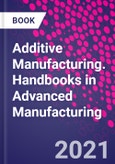Additive Manufacturing explains the background theory, working principles, technical specifications, and latest developments in a wide range of additive manufacturing techniques. Topics addressed include treatments of manufactured parts, surface characterization, and the effects of surface treatments on mechanical behavior. Many different perspectives are covered, including design aspects, technologies, materials and sustainability. Experts in both academia and industry contribute to this comprehensive guide, combining theoretical developments with practical improvements from R&D. This unique guide allows readers to compare the characteristics of different processes, understand how they work, and provide parameters for their effective implementation.
This book is part of a four-volume set entitled Handbooks in Advanced Manufacturing. Other titles in the set include Advanced Machining and Finishing, Advanced Welding and Deformation, and Sustainable Manufacturing Processes.
Please Note: This is an On Demand product, delivery may take up to 11 working days after payment has been received.
Table of Contents
1. Introduction to Additive Manufacturing 2. Introduction to Powder Bed Fusion of Polymers 3. Selective Laser Melting: Principles and Surface Quality 4. Laser Directed Energy Deposition. Principles and Applications 5. Vat Photopolymerization Methods in Additive Manufacturing 6. Polymer and Composites Additive Manufacturing: Material Extrusion Processes 7. Introduction to Fused Deposition Modeling 8. Electron Beam Melting Process: A General Overview 9. Introduction to 4D Printing: Methodologies and Materials 10. Laser polishing of Additively Manufactured parts 11. On Surface Quality of Engineered Parts Manufactured by Additive Manufacturing and Post Finishing by Machining 12. Standards for Additive Manufacturing Technologies: Structure and Impact 13. Metal Matrix Composites Processed by Laser Additive Manufacturing: Microstructure and Properties 14. Laser Aided Metal Additive Manufacturing and Post Processing: A Comprehensive Review 15. Nano-functionalized 3D Printing 16. Additive Manufacturing for the Automotive Industry 17. Additive Manufacturing of Large Parts 18. 3D printing of Pharmaceutical Products 19. 3D Bioprinting: A Step Forward in Creating Engineered Human Tissues and Organs 20. Additive Processing of Biopolymers for Medical Applications 21. Additive Manufacturing using Space Resources 22. Modelling and Simulation of Additive Manufacturing Processes with Metallic Powders ? Potentials and Limitations Demonstrated on Application Examples
Authors
Juan Pou Professor, Applied Physics Department, School of Engineering, University of Vigo, Spain. Prof. Juan Pou (Ind.Eng., MSc., Ph.D.) holds a professor chair of Applied Physics at the University of Vigo (Spain). He was director of the Research Center for Advanced Industrial Technologies and Processes (2009-2011), and dean of the Faculty of Engineering (2011-2016) at the University of Vigo. He has extensive experience (more than 30 years) in different laser-assisted processes such as LCVD, PLD, laser cladding, cutting, micro/nano fabrication, etc. His current research deals with the additive manufacturing for biomedical applications, developing laser surface treatments for improving implants performance, or laser spinning of bioglass nanowires for bone recovery. Prof. Pou did research stays in the National Physical Laboratory (UK), Fraunhofer-Institut f�r Lasertechnik (Germany), and Rutgers University (USA). He has been also Invited Professor at the Department of Mechanical Engineering at Columbia University in New York (USA). He is author of 150+ peer-reviewed journal articles, chapter books and patents. In addition, he has participated in more than 50 R&D projects for European Union, Spanish Government, and companies in the field of laser technology. He is the member of various journal's editorial boards and serves in the scientific committee of many international conferences. Antonio Riveiro Lecturer, Department of Materials Engineering, Applied Mechanics and Construction, School of Engineering, University of Vigo, Spain. Dr. Antonio Riveiro is lecturer in the Department of Materials Engineering, Applied Mechanics and Construction (School of Engineering) at University of Vigo (Spain), where he teaches courses on solid mechanics, and laser processing. He received his PhD in Applied Physics (2009) from the University of Vigo, and did postdoctoral stays at University of Manchester (School of Materials), Imperial College London (Department of Materials) and University of Minho (3B's Research Group in Biomaterials, Biodegradables and Biomimetics). He specializes in laser materials processing, focusing on the application of laser processes for biomedical applications. His research interests also include, laser surface engineering for modification of wetting properties of advanced materials, laser synthesis of micro- and nanomaterials, synthesis and laser processing of bioactive glasses. He is author of 100+ peer-reviewed journal articles, chapter books, and patents. He is editor of Metals, PLOS ONE, and Advances in Materials Science and Engineering journals. J. Paulo Davim Department of Mechanical Engineering, University of Aveiro, Aveiro, Portugal.J. Paulo Davim is a full professor at the University of Aveiro, Portugal. He is also distinguished as an honorary professor in several universities and colleges in China, India, and Spain. He is the series editor of Elsevier's Woodhead Publishing Reviews: Mechanical Engineering Series.
J. Paulo Davim Professor, Department of Mechanical Engineering, University of Aveiro, Portugal. J. Paulo Davim is a Professor in the Department of Mechanical Engineering of the University of Aveiro, Portugal. He has more than 30 years of teaching and research experience in Manufacturing, Materials and Mechanical Engineering with special emphasis in Machining & Tribology. He has also interest in Management & Industrial Engineering and Higher Education for Sustainability & Engineering Education. He has received several scientific awards, has worked as evaluator of projects for international research agencies as well as examiner of Ph.D. thesis for many universities. He is the Editor in Chief of several international journals, Guest Editor of journals, books Editor, book Series Editor and Scientific Advisory for many international journals and conferences. Presently, he is an Editorial Board member of 30 international journals and acts as reviewer for more than 80 prestigious Web of Science journals. In addition, he has also published as editor of more than 100 books and as author of more than 10 books, 60 book chapters and 400 articles in journals and conferences.






